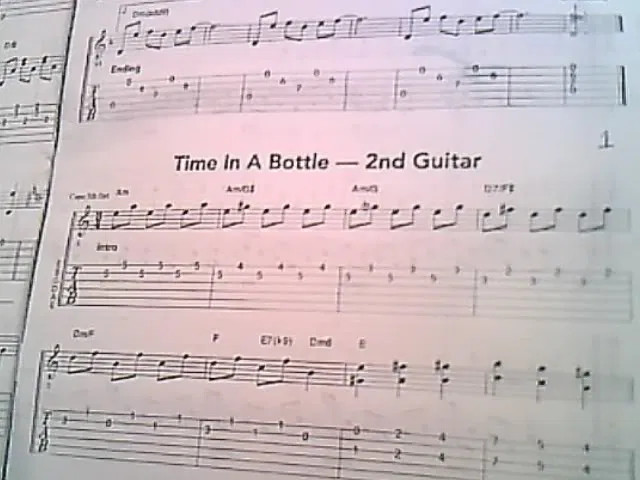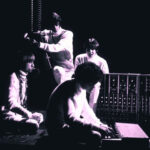Jim Croce’s “Time in a Bottle” is a timeless classic, beloved for its heartfelt lyrics and delicate guitar work. For aspiring guitarists, learning to play this song is often a cherished goal. If you’re diving into guitar tabs and feeling a bit perplexed by the complexities of “Time in a Bottle,” especially Maury Muehleisen’s intricate second guitar part, you’re not alone. Many beginners encounter questions about unusual chord shapes, capos, and unfamiliar chord names when first encountering this beautiful song.
This guide will break down some of the common questions that arise when learning “Time in a Bottle” on guitar, inspired by a fellow guitarist’s query about a Pete Huttlinger lesson. We’ll explore the mysteries behind the capo, unusual chord voicings, and those seemingly complicated chord names, making this song more accessible to players of all levels.
Decoding the Capo in “Time in a Bottle”: It’s All About Key and Harmony
One of the first things that might catch your eye when looking at the tab for “Time in a Bottle” is the instruction to place a capo on the 5th fret. If you’re new to capos, this little device can seem a bit mysterious. Simply put, a capo acts like a movable nut, effectively shortening the strings and raising the pitch of your guitar.
Why the 5th Fret? In the case of “Time in a Bottle,” the capo on the 5th fret is crucial for achieving the song’s intended key and the beautiful interplay between two guitars. “Time in a Bottle” cleverly shifts between keys: the verses are in D minor, while the choruses transition to D major.
Maury Muehleisen’s second guitar part, often played with a capo, is designed to harmonize with Jim Croce’s guitar, creating rich textures and a fuller sound. Using a capo allows guitarists to play familiar open chord shapes while actually producing notes in a different key.
Consider this: placing a capo on the 5th fret raises the pitch by five half-steps, or two and a half whole steps. So, when the tab shows an Am chord with the capo at the 5th fret, you’re actually playing a Dm chord in terms of actual pitch. This D minor is the key of the verses in “Time in a Bottle.” If you were thinking in terms of C major/A minor, shifting up two and a half steps from C major brings you to F major, which is the relative major of D minor – it all connects musically!
The original question pointed out confusion: “The key is C or Am, puts a Capo on the fifth fret, and plays an Am chord on the tenth fret… this does not make sense to me.” Hopefully, now it starts to make more sense. The tab is written relative to the capo. The “Am chord on the tenth fret” (which is actually played in open position relative to the capo) is indeed an Am shape, but because of the capo, it sounds as a Dm chord, fitting perfectly within the key of the verse.
Why Use a Capo at All? Why not just play in D minor without a capo? There are several reasons why guitarists use capos, especially in two-guitar arrangements like Jim Croce’s songs:
- Open String Resonance: Capos allow guitarists to utilize open strings in higher registers. Open strings resonate more freely and produce a richer, more sustained sound. Muehleisen’s part in “Time in a Bottle” beautifully incorporates open strings, creating those signature arpeggiated textures. Without a capo, achieving these voicings higher up the neck would be far more difficult, if not impossible.
- Voicing Options and Harmony: Using a capo allows two guitarists to play in complementary registers of the guitar neck. One guitarist might play lower down the neck in open position, while the other uses a capo to play higher up, creating a wider sonic range and richer harmonies. This technique is also prominent in “I’ll Have To Say I Love You In A Song,” another Jim Croce classic, where Muehleisen uses a capo at the 7th fret.
- Playing in Different Keys with Familiar Shapes: For songwriters and performers, capos are invaluable tools for quickly changing the key of a song without having to relearn chord shapes. If a song is too low or high for a singer’s vocal range, a capo can easily transpose it.
 Time in a Bottle by Jim Croce
Time in a Bottle by Jim Croce
The guitar tab excerpt from Pete Huttlinger’s lesson on “Time in a Bottle” showcasing the beginning of Maury Muehleisen’s second guitar part, highlighting the use of a capo and Am chord shape.
Deciphering the “Unusual” Am Chord: Voicing and Harmony in Action
The next question raised was about the Am chord in the first measure of the tab, noting it “does not look like a regular Am.” This is a fantastic observation and gets to the heart of guitar playing and arranging.
Chord Voicings Explained: A chord is simply a combination of specific notes. An Am chord, for instance, is composed of the notes A, C, and E. However, there are many different ways to arrange these notes on the guitar fretboard – these are called “voicings.” A standard open position Am chord is just one voicing.
In the “Time in a Bottle” tab, particularly in Muehleisen’s part, you often see simplified chord voicings. In the first measure, the tab indicates an Am chord, but it only involves playing the A note (5th fret of the E string) and the E note (5th fret of the B string).
Harmony Through Shared Notes: Why just two notes for a chord? In a two-guitar arrangement, the harmonic responsibility is often shared. Jim Croce’s guitar part is likely providing other notes of the Dm chord (remember the capo!), such as the F note. Muehleisen’s part focuses on providing the root (D, played as A shape with capo) and the fifth (A, played as E shape with capo) of the Dm chord, creating a foundational harmony without needing to play a full, six-string chord voicing.
Think of it like a conversation between two guitars. They don’t need to say the same thing at the same time to communicate effectively. Muehleisen’s simplified Am (sounding as Dm) voicing is perfectly placed within the overall harmonic context of the song.
Navigating “Weird” Chord Names: Slash Chords and Extensions
Finally, the question about “weird chord names like D7/F#, E7 (b9) etc.” is a common one for guitarists venturing beyond basic chords. These names might seem intimidating at first, but they are actually quite logical once you understand the underlying music theory.
Slash Chords (D7/F#): The “D7/F#” is an example of a “slash chord.” The letter before the slash (D7) indicates the chord itself, and the letter after the slash (F#) specifies the bass note. So, D7/F# means a D7 chord with an F# note in the bass. This creates a specific harmonic color and often a smoother bass line movement. You can learn more about slash chords in resources like guitar lessons on songs like “Eleanor Rigby,” which often utilize them.
Extended Chords (E7(b9)): Chords like “E7(b9)” are “extended chords.” They add extra notes beyond the basic triad (root, third, fifth) to create richer harmonies. “E7” is an E dominant 7th chord, and “(b9)” indicates a flattened 9th is added to the chord. These chords are common in jazz, blues, and sophisticated pop music, adding complexity and flavor.
Don’t Be Intimidated! While these chord names might look complex, the crucial takeaway for learning “Time in a Bottle” is not to get bogged down in music theory initially. Focus on learning the finger positions for these chords as they appear in the tab. Your ear will guide you, and as you become more comfortable, you can delve deeper into understanding the theory behind these chord names.
Tips for Learning “Time in a Bottle” as a Beginner
If you felt a bit overwhelmed by the tab initially, rest assured, “Time in a Bottle” is achievable for beginner to intermediate guitarists. Here are some tips:
- Start Slow and Section by Section: Don’t try to learn the entire song at once. Break it down into smaller, manageable sections (verses, choruses, intro, etc.).
- Focus on Chord Transitions: Smooth transitions between chords are key to playing this song beautifully. Practice changing chords slowly and deliberately at first, gradually increasing speed as you become more comfortable.
- Listen to the Original Song Frequently: Immerse yourself in Jim Croce’s recording. Pay attention to the rhythm, dynamics, and the interplay between the guitars. This will help you internalize the feel of the song.
- Utilize Online Resources: Beyond tabs, explore video lessons and tutorials for “Time in a Bottle.” Seeing someone play the song and explain techniques can be incredibly helpful.
- Be Patient and Persistent: Learning guitar takes time and practice. Don’t get discouraged if it doesn’t sound perfect right away. Keep practicing, and you’ll gradually improve.
Conclusion: Embrace the Journey of Learning “Time in a Bottle”
“Time in a Bottle” is a rewarding song to learn on guitar. It’s not just a beautiful melody; it’s also a fantastic opportunity to expand your understanding of guitar techniques like using a capo, exploring chord voicings, and encountering more advanced chord harmonies.
By demystifying some of the initial questions and complexities, we hope this guide has made “Time in a Bottle” feel more approachable. So, pick up your guitar, put on that capo, and embark on the journey of learning this timeless classic. You’ll not only learn a wonderful song but also deepen your appreciation for the artistry of Jim Croce and Maury Muehleisen’s guitar arrangements. Happy playing!

